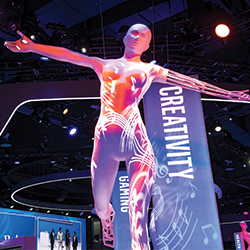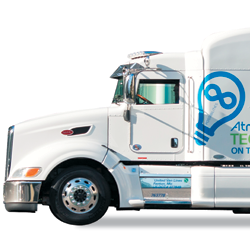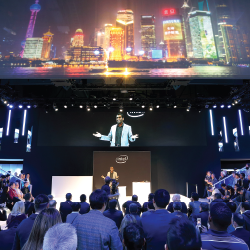CAse study |

|
 hrough years of heavy-duty marketing efforts and the strength of its product, Intel Corp. developed name recognition for its brand and its iconic "Intel inside" tagline. But just because consumers know the company's name doesn't mean that brand awareness necessarily translates into an adequate understanding of the company's products, especially considering that those products - computer chips and related technology - aren't directly seen or touched by the end user. hrough years of heavy-duty marketing efforts and the strength of its product, Intel Corp. developed name recognition for its brand and its iconic "Intel inside" tagline. But just because consumers know the company's name doesn't mean that brand awareness necessarily translates into an adequate understanding of the company's products, especially considering that those products - computer chips and related technology - aren't directly seen or touched by the end user.
That's the conundrum Intel Corp. faces on a daily basis. The Santa Clara, CA-based company manufactures one of the most important elements inside a computer: the processing chip. And while consumers may generally associate the Intel name with personal computing, its products aren't sitting on a shelf at the local electronics store - they're found inside other companies' laptop and desktop computers. So educating consumers on the importance of Intel's chip is an essential step toward convincing them to insist on computers with Intel inside.
While Intel uses print and television ads to boost consumer knowledge about its products, the annual International Consumer Electronics Show in Las Vegas allows the company to literally reach out to consumers and teach them about its offerings. The show also presents Intel with an opportunity to give its less tangible products, such as its WiMax technology, an easy-to-understand identity.
"Like every CES show, the challenge for any company is to stand out from the crowd," says Jerrie Ames, senior creative director at Live Marketing, one arm of the creative team responsible for Intel's CES exhibits. "It's especially difficult for Intel. Since they don't make a consumer product, per se, but rather a component within other companies' products, they have to find a way to make the Intel brand real for the attendees."
At the 2007 CES show, Intel used experiential activities to demonstrate the capabilities of its Core 2 Duo processor. The activities included compare-and-contrast gaming that allowed attendees to experience single-core and duo-core computing, and a video-editing demonstration that showcased the Core 2's speed. Not only did Intel's exhibit attract thousands of attendees, the activities kept them in the exhibit for an average of 10 minutes each.
The 2007 CES booth proved wildly successful (the number of attendee interactions more than doubled from the previous year), handing the Intel team a strong foundation on which to build its next exhibit for CES.
So heading into the 2008 show, Intel set out to maintain the attendee flow to its exhibit and educate at least 10,000 booth visitors about the company's offerings, including WiMax, a wireless broadband technology with coverage-area capabilities similar to a cell phone. And in proven Intel style, it didn't just want to tell attendees about the product, it wanted to let them feel and understand the technology in a way that brought WiMax to life.
On the Right Track
Intel had already established a knack for drawing crowds via interactive experiences; now the trick was to figure out how to demonstrate an abstract concept: wireless connectivity. Victor Torregroza, events program manager for Intel's corporate event marketing group, planned to expand on the company's 2007 booth, adding additional activities. Still, it was a given that WiMax required even more than your run-of-the-mill booth activity; it needed something extraordinary to demonstrate the blazingly new technology. But how do you show the superiority of a wireless technology to a crowd of 10,000 people within a 100-by-120-foot exhibit space?
|
 |
Speed Racer
Once inside Intel's exhibit, attendees gathered around the F1 racing simulators for the chance to participate in the Broadband on the Go racing experience. Meanwhile, at the off-site Pit Lane Park, visitors took part in a variety of race-inspired activities and watched the miniature racers - which were controlled by drivers inside the exhibit - zoom around the track. |
 |
|
In hopes of answering that question, Torregroza and his Intel exhibit team sat down with representatives from Live Marketing and 2LK Design Ltd. in October 2007 for a massive two-day brainstorming session in Chicago.
John Christian, a technical marketing engineer for Intel, tossed out an idea. With the great strides the military has seen in remotely piloted vehicles, could Intel set up something with WiMax-enabled computers and remote-controlled miniature race cars?
A connection between racing and Intel already existed. A key activity in the previous year's booth, the BMW Sauber Formula 1 Team Racing Experience, drew some 1,300 attendees who tested their driving skills inside in-booth racing simulators. Plus, Intel had partnered with BMW and F1 racing since 2006, when the two companies created Pit Lane Park, a racing-style mobile theme park that travels the world to various F1 racing events, promoting the companies and their products. In fact, Pit Lane Park was already scheduled to be in Vegas during the 2008 CES show, in a parking lot adjacent to the Las Vegas Convention Center.
Christian's WiMax concept was simple: Allow attendees to compete head-to-head in racing simulators inside the exhibit, but showcase the magic of WiMax by rigging the in-booth simulators to control miniature cars on a race track, which would be located at Pit Lane Park, nearly a mile away from the Intel booth. In one fell swoop, the innovative experience would attract and entertain attendees, while demonstrating the capabilities of WiMax technology - and keeping the crowd in the booth long enough to soak up the Intel message.
Start Your Engines
With a basic concept in place for its WiMax demo, Intel plastered promotional messages on three Las Vegas billboards, purchased a host of print ads, and distributed countless on-site handouts beckoning tech-crazed attendees to Intel's booth and Pit Lane Park in hopes of attracting its share of CES attendees. Plus, news reports and video footage taken by attendees during the show hit the Internet almost instantly, with various blogs, media sites, and YouTube all passing along the word of Intel's WiMax demonstrations.
Additional activities at Pit Lane Park kept the buzz building. A real BMW F1 racer and professional driver spent two days in Pit Lane Park, burning rubber, spinning donuts, and building even more excitement for the off-site event, which ran concurrently with CES.
During their visit to Pit Lane Park, visitors could take a peripheral vision and coordination test to prove their race-worthy meddle. Another activity area allowed attendees a chance to be part of a "pit crew," demonstrating how quickly they could change a tire on an actual F1 racer.
|
Staffers at Pit Lane Park made certain attendees understood that the fun went beyond the boundaries of the park, by inviting them to visit Intel's booth inside the convention center. There, they could participate in seven interactive activities, more than twice the amount of experiential activities featured in Intel's 2007 exhibit. But the one that had everyone talking was the WiMax demo, positioned in the northeast corner of the 12,000-square-foot space.
In the exhibit, staffers invited random attendees to climb into one of two life-sized F1 race-car simulators outfitted with steering wheels, brake pedals, gas pedals, and an Intel-equipped, WiMax-imbedded laptop in front of the driver, which controlled one of two miniature race cars a mile away on the track at Pit Lane Park. Simultaneously, cameras attached to sub-compact WiMax-equipped laptops installed in the miniature race cars sent their signals back to the computers in the booth via WiMax, giving attendees in the full-size simulators a driver's-eye view of the track.
While high-definition screens in the booth and at Pit Lane Park let the audience follow along with the action, the two drivers revved up their tiny remote engines and steered the little cars around the track for the three-minute race, vying for the title of "winner" and an Intel-branded baseball cap. During the race, an in-booth host kept in contact with an on-scene "reporter" at Pit Lane Park. The two actors followed a detailed script that put a newsy spin on the race, as the patter educated the captive audience about WiMax technology and its unique benefits.
Not only did the anchors disseminate important information to their audiences, the interaction between the two actors helped cement the connection in attendees' minds between the trade show booth and the off-site location a mile away. The anchor and the reporter urged onlookers to visit the other end of the action, sending attendees from the park to the convention center and vice versa.
All told, the cross promotion between the exhibit and Pit Lane Park reached more than 15,000 attendees with Intel's revved-up message about WiMax. At Pit Lane Park, roughly 8,000 people cheered on the mini race cars. Meanwhile, more than 300 attendees stepped into the driver's seat in the Intel booth during the course of the four-day show, with some 7,500 onlookers watching.
|
 |
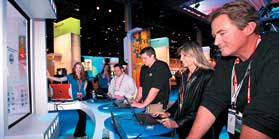 |
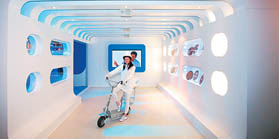 |
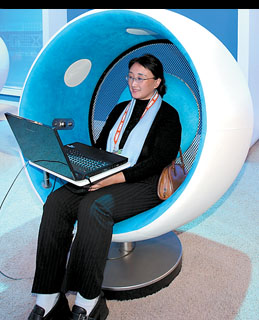 |
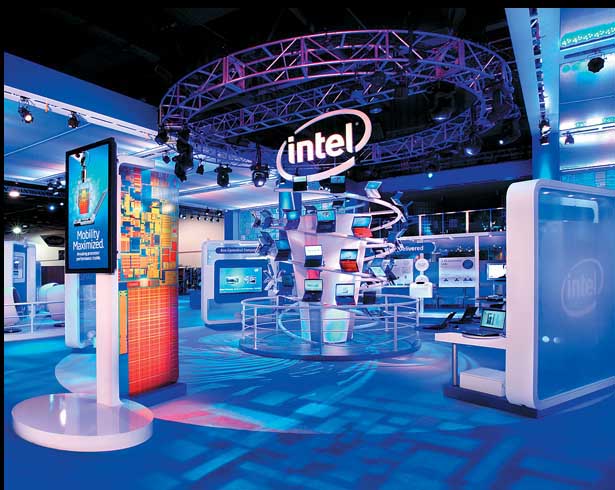 |
It's All Inside
Intel Corp. filled its 120,000-square-foot exhibit with interactive competitions and demonstrations that allowed attendees to experience the company's technology firsthand. There, attendees could chill out in the immersive Hi-Def Lounge, film their own mini movie and upload it to YouTube, or compete head to head for the title of "Silicon Rock Star," all the while learning about the benefits of Intel's high-tech offerings. |
|
Driving Traffic
While the WiMax racing activity drew thousands of attendees to Pit Lane Park and Intel's exhibit, it wasn't the be-all end-all of the company's CES experience. The 2007 booth featured a variety of experiential activities designed to appeal to a wide audience, and the 2008 exhibit used that same template, offering even more options for attendees.
In the 45nm Exploratorium, five different stations drew attendees to partake in their choice of activities. At one station, booth staffers posed the question: "Are You a Silicon Rock Star?" The query was followed by some serious competition, as four attendees at a time battled each other to answer eight technology-related questions quickly and correctly, using Intel-equipped laptops to fire off their answers.
For history buffs and true techies, the Changing the World activity offered attendees a more laid-back experience. The hands-on museum-style display hyped the proven reality of Moore's Law - the 1965 prediction of Gordon Moore, co-founder of Intel, which forecasted that the number of transistors on a computer processing chip will double approximately every two years.
Visitors could look through a device similar to a child's ViewMaster and see the actual size of a transistor compared to a blood vessel and understand how many millions of transistors can be placed on an Intel processor to enable faster computing.
"The self-guided area was a nice, simple, clean way for people to get more information about Intel and to learn something new," Torregroza says.
Over at the Eco-Conscious Computing station, a booth staffer explained about Intel's involvement with the Climate Savers Computing Initiative (CSCI), which the company launched in partnership with Google in 2007. The initiative urges businesses and organizations to develop and employ eco-friendly technology.
|
There, a quiz let booth visitors get involved via a 61-inch touchscreen. Following the quiz, attendees learned more about the initiative and were invited to join Intel's environmental efforts by signing up for the CSCI at an adjacent laptop. Those who did so earned an organic-cotton CSCI-branded T-shirt.
Beyond the Exploratorium, the Performance Zone involved green-screen technology that let attendees star in and edit a short video, while learning how Intel technology makes the process easy and efficient. Meanwhile, the Hi-Def Lounge offered attendees a spot to sit and relax in pod-style chairs equipped with embedded sound systems and Intel-powered laptops where visitors could watch clips from the "Planet Earth" documentary.
With so many stations and activities to entertain them, 26,000 attendees spent an average of more than 10 minutes in the booth, a cumulative total of nearly 4,784 educational hours learning about Intel and the benefits of its products.
The Victory Lap
Through an on-site survey of 389 attendees who visited the Intel booth, the company learned that 96 percent of attendees described the booth as fun, engaging, and informative, while 92 percent reported they would recommend the Intel exhibit as a "must-see" destination for other CES attendees.
But the benefits spread much further than the convention center or even Las Vegas. Viral marketing took the buzz to the World Wide Web. There, videos of the racing activity and other Intel booth experiences received more than 28,000 hits, almost 50 percent more than the year before.
"We were able to connect our interactive, activity-rich exhibit with Pit Lane Park using WiMax in a way that helped guests understand the benefits of the new technology," Torregroza says.
By the time Pit Lane Park rolled out of town and the last attendee left the exhibit, Intel had touched approximately 26,000 visitors with its key messages, proving that having Intel inside - and outside, for that matter - is more than a company tagline, it's also smart marketing. e
|
|
|
|
|




 hrough years of heavy-duty marketing efforts and the strength of its product, Intel Corp. developed name recognition for its brand and its iconic "Intel inside" tagline. But just because consumers know the company's name doesn't mean that brand awareness necessarily translates into an adequate understanding of the company's products, especially considering that those products - computer chips and related technology - aren't directly seen or touched by the end user.
hrough years of heavy-duty marketing efforts and the strength of its product, Intel Corp. developed name recognition for its brand and its iconic "Intel inside" tagline. But just because consumers know the company's name doesn't mean that brand awareness necessarily translates into an adequate understanding of the company's products, especially considering that those products - computer chips and related technology - aren't directly seen or touched by the end user.  In one fell swoop, the innovative experience would attract and entertain attendees, while demonstrating the capabilities of WiMax technology - and keeping the crowd in the booth long enough to soak up the Intel message.
In one fell swoop, the innovative experience would attract and entertain attendees, while demonstrating the capabilities of WiMax technology - and keeping the crowd in the booth long enough to soak up the Intel message.









 With so many stations and activities to entertain them, 26,000 attendees spent an average of more than 10 minutes in the booth, a cumulative total of nearly 4,784 educational hours learning about Intel and the benefits of its products.
With so many stations and activities to entertain them, 26,000 attendees spent an average of more than 10 minutes in the booth, a cumulative total of nearly 4,784 educational hours learning about Intel and the benefits of its products.